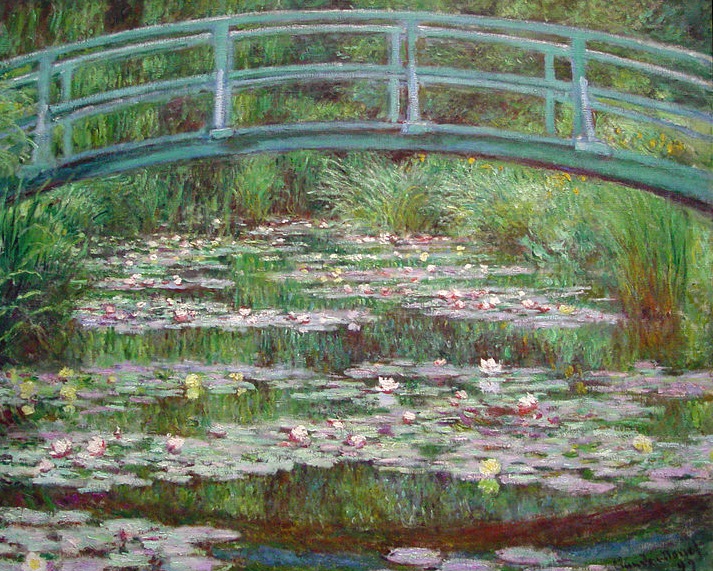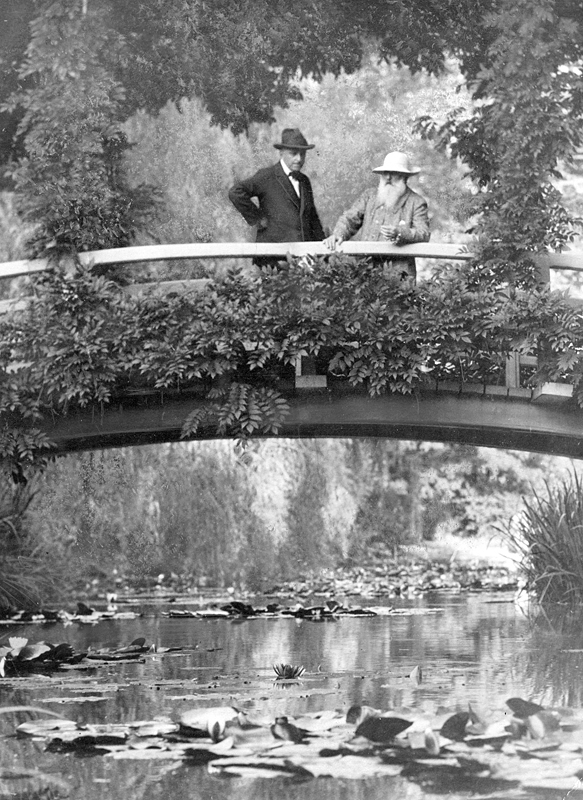Guess what’s missing at Giverny?
The school of French Impressionism, as everyone surely knows, was named after Claude Monet’s famous avant-garde painting ‘Impression, soleil levant, 1872’
It was so stylistically advanced that critics who didn’t understand Monet’s objectives used the word ‘Impressionism’ as a pejorative. Today the work easily gains a place amongst the most famous artworks ever painted.
The iconic impressionist
During his long life, Monet’s output was immense. He is reputed to have painted every day all over France—and for a few years in London where he was dodging the draft.
In 1883, middle-aged and nearly penniless, he settled in Giverny with his wife Camille, his mistress Alice, and their eight children. Monet’s love of an extravagant lifestyle, and his position—then only on the periphery of the French art scene—meant that the family was often in financial distress.
The French laws governing waterways were another major problem. They were both complex and entrenched, and getting permission to divert the River Ru to create a pond was convoluted and frustrating.
But the late 1880s saw a turning point.
Monet’s standing increased steadily in France after showing his series of haystacks, poplars and Seine waterways. Plus, two very well-received New York exhibitions were all the start of his international recognition. He went on to become one of the world’s best-known artists, amassing a considerable fortune which allowed him to develop the famous property.
The Monet legacy at Giverny
Well, there’s plenty to see, that’s for sure—as evidenced by the over half a million tourists Giverny attracts every year.
The visitor is greeted by an imposing, wisteria-covered, rural complex surrounded by extensive gardens. A network of paths leads through beds of strikingly coloured geraniums, rhododendrons, irises and flowering shrubs and trees to the focal point—the water lily pond and Japanese bridge that were to make him so famous.
The centrepiece is the imposing farmhouse with pink exterior and green shutters. Inside you’ll find a complex of large interlinked rooms, all decorated in Monet’s favourite colours and encrusted with his collection of paintings by friends—Manet, Pissarro, Degas and Cezanne—and, of course, many others by Monet himself.
His most famous series of Grandes Décorations which each measure two metres high by four metres wide were actually painted at Giverny in a huge studio specially built in his later life.

Of course, there’s the mandatory museum shop at Giverny where you can get just about anything you like with Monet branding: books (in almost any language), cushions, spectacle cases, mirrors, pill boxes, fridge magnets, umbrellas, greetings cards, necklaces, posters, towels, scarves, ties, bags, purses, etc, etc—but thankfully no water lily toilet seats. (They are available, but you’ll have to search online for them).
The real deal or pas?
So, back to my question: exactly what is it that’s missing at Giverny?
Well, the short answer is this: there are no Monets!
All the pictures you’ll see at the Fondation Claude Monet are prints or copies. And they’re everywhere.
BUT NOT AN ORIGINAL MONET IN SIGHT.
Every one of the paintings on display is the kind of thing you can buy yourself at any poster or souvenir shop. Or at millions of retail outlets worldwide. Or from a multitude of online sites who will deliver your Monet of choice right to your front door.
But don’t let this personal and petty prejudice detract from your visit.
Monet’s Giverny is a great place to visit and a truly memorable experience.
Here’s the solution if you’re desperate to see a genuine Monet. Only a few kilometres away, in the pretty town of Vernon, you’ll find ‘Le Musée A.G. Poulain’.
It’s the proud owner of two original Monets:
- ‘Nympheas, 1908’ and
- ‘Effet de soleil couchant à Pourville, 1896’.
Il vaut le voyage, don’t you think if you’re desperately in need of a bona fide Claude Monet fix?
Have you ever visited the Normandy village of Giverny? What is your favourite artwork by Monet? Share your comments and experience with us below.
Image Credits
- Jardin Monet by Remi Jouan via Wikimedia Commons
- Impression soleil levant by Wartburg via Wikimedia Commons
- Japanese Footbridge by Alexander Pruss via Wikimedia Commons
- The house at Giverny by shogunangel via flickr
- Monet in his beloved garden by New York Times via Wikimedia Commons











Quite true although I hadn’t really noticed! I did see a real Monet in the principal’s office in Paris at the Lycée Claude Monet. Just hanging on her wall..on loan from the family. Not a big canvas but still impressive to have one just there on the wall in the office!
Impressive! A monet on the wall in your office! I agree – wow 🙂
Bonjour and thanks for your comments.
I must confess that I wondered around wondering what I was really looking for until I realised what was missing. Luckily though, I found some Monets really close by.
Thanks again.
Ray
Hi Ray – but would you have priceless masterworks on your walls with a million peeps a year wandering about? I’ll bet my croissant you wouldn’t! Not without armed security and a cordoned barrier… As I remember the house at Giverny I was quite free to wander wherever, albeit in a huge crush of humans, not a safe place for any million-dollar Monet. Off, then, to Musée de l’Orangerie where I sat for a couple of hours wrapped around by water lilies. People came and went, but for those who sat, the experience in that room of domed light was extraordinary. The paintings began to pulsate – I am not alone in that insight. The house and gardens of Giverny are, as you say, so worth a visit. They are an experience in their own right.
Oh Nigelle, you’re desription takes me right back to Musée de l’Orangerie – Ahhh merci.
Bonjour Nigelle,
Thanks for your email and for reading my article.
No doubt the Orangerie is the place to imerce yourself in Montes waterlilies.
However, Agen is our nearest gallery of note and it’s quite a sleepy – but delightful – place where you can go right up to the originals, including a Monet and several Goyas. No wonder it’s called la France profonde.
Amicalement.
Ray